Gauleiter
A Gauleiter (German pronunciation: [ˈɡaʊlaɪtɐ]) was the party leader of a regional branch of the Nazi Party, the head of a Gau or Reichsgau. The word can be singular or plural, depending on its context. Gauleiter was the second highest Nazi Party paramilitary rank, subordinate only to the higher rank Reichsleiter and to the position of Führer. During World War II, the rank of Gauleiter was obtained only by direct appointment from Adolf Hitler.
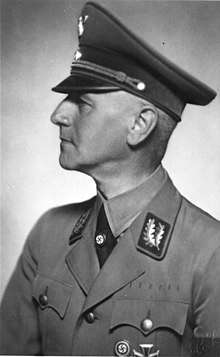
History
Creation and early usage
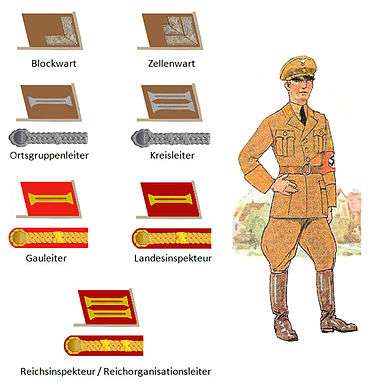
The first use of the term Gauleiter by the Nazi Party was in 1925 after Adolf Hitler refounded the Nazi party following the failed Beer Hall Putsch. The name derives from the German word Gau and Leiter (meaning leader). The word Gau is an old term for a region of the German Reich. The Frankish Realm and the Holy Roman Empire were subdivided into Gaue (the plural form of Gau), which corresponds roughly with the English word "shire". It is still in use today for some regions in Belgium and Switzerland, and in the modern German states of Rhineland-Palatinate, Baden-Württemberg, Saarland and Bavaria (see: Gau Legacy).
In the earliest days of the term's existence, Gauleiter were heads of election districts during a time period when the Nazis were attempting to gain political representation in the Weimar Republic. Gauleiter oversaw several politische Leiter (political leaders) who assisted the Nazis with election campaigns and hosted senior Nazis (such as Hitler) on campaign tours.
In 1928, a mid-level official known as a Kreisleiter was introduced as an intermediary between the Gauleiter and the political leaders. In July 1932, as the Nazis attempted to organize on a national level, Gauleiter were themselves subordinated to 10 new officials known as a Landesinspektors, each in charge of several Gaue within a specified geographic area. This reorganization, the brainchild of Gregor Strasser, was short-lived and abandoned in December 1932, after Strasser's resignation.[1]
Nazi Germany
In 1933, when the NSDAP took power and established the state of Nazi Germany, Gauleiter became the second highest Nazi paramilitary rank, just below the new rank of Reichsleiter (National Leader). The Gauleiter now became the heads of the Gauleitung — the system of Nazi political regions set up to mirror the German states.
In theory, a Gauleiter merely functioned as a representative of the Nazi Party who served to coordinate regional Nazi Party events and also served to "advise" the local government. In practice, each Gauleiter had unquestioned authority in his particular area of responsibility. The legal governmental establishment merely existed as a rubber stamp for the Gauleiter. Party control over the civil administration became institutionalized, as in many (but not all) cases the Gauleiter also held the supreme civil administrative post in his area. This could be as Reichsstatthalter in the states (Länder) or as Oberpräsident in the Prussian provinces. The Gauleiters of all Reichsgaue and of 11 Gaue in Germany proper also served as Reichsstatthalters.[2] However, since Party Gau boundaries and provincial/state boundaries did not necessarily coincide, this arrangement sometimes led to mutually overlapping jurisdictions and added to the administrative chaos typical of Nazi Germany.
Within each Gau were a number of Kreise (districts or counties, singular: Kreis in German), followed by the Ort (municipal) level, which was the lowest in the Nazi Party organization. There were also two additional lower local levels (Block and Zelle), describing Party Cells and local Neighborhood Blocks. By this point, all political leaders wore official uniforms, with piping and collar-tab background colors indicating the level of the Party (Local, County, Regional, or National) that a Political Leader served.
World War II
When World War II broke out in Europe on 1 September 1939, fifteen Gauleiters were appointed Reich Defense Commissioners (Reichsverteidigungskommissar), one in each military district (Wehrkreis) of Germany and Austria. They were charged with organizing civil defense and mobilization activities, including air defense and evacuation. On 16 November 1942, all 42 Gauleiters were appointed as Reich Defense Commissioners in their juridictions.[3] This led to further jurisdictional conflict between the military and civil authorities.
Toward the end of the war in October 1944, the Nazi Party created a national militia, the Volkssturm. Each Gauleiter was charged with the organization, enrollment, training and leadership of the Volkssturm batallions in their jurisdiction. These units were staffed by conscripting males between the ages of 16 and 60 years who were not already serving in the military. The Volkssturm comprised one of the final components of the total war effort promulgated by Joseph Goebbels in his role of Reich Plenipotentiary for Total War.[4]
Insignia
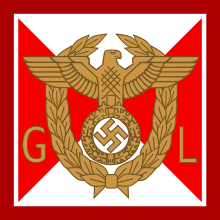
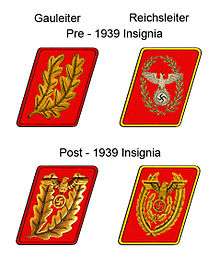
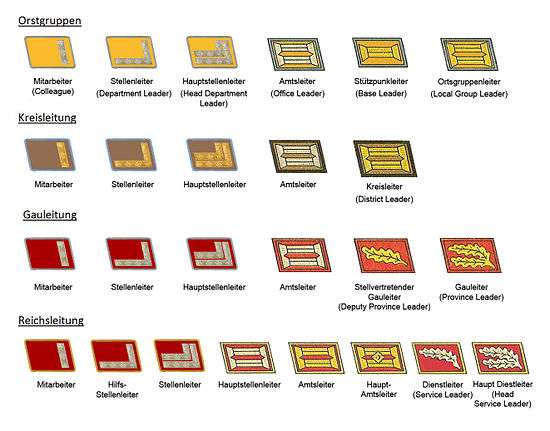
The original insignia for a Gauleiter consisted of Army styled collar tabs, accompanied by a braided shoulder cord worn on a brown Nazi Party shirt. After 1933, the Gauleiter adopted a two oak leaf insignia worn on a brown colored collar patch. The Stellvertreter-Gauleiter (Deputy-Gauleiter) wore a single oak leaf.
By 1939, the entire Nazi Party paramilitary rank system had been overhauled, introducing completely new insignia consisting of pips, bars, and as many as four miniature oak leaves per collar to represent Nazi Party political rank. The Gauleiter insignia, however, was considered too well "entrenched" to change and thus was not incorporated into the new insignia system. Instead, the Gautier continued to wear the pre-war two oak leaf insignia, with the rank seen as existing outside of the hierarchy, senior to all other Nazi Party ranks, with the exception of Reichsleiter. Both Gauleiter and Reichsleiter insignia was modified slightly to display a more pronounced national eagle crest, and both ranks were permitted to wear special party armbands.
Gauleiter also had the right to display a special vehicle flag when traveling, as a status symbol of their position.
Relationship with other insignia
All political leaders working at Gau level had rhomboid collar tabs with red facings (not brown), with a dark wine-red (burgundy) colored piping around the outer edges. Reich-level collar tabs had a bright crimson facing, with gold piping; Kreis level tabs had a dark chocolate brown facing, with white piping, while Ort level tabs had a light brown facing with light blue piping. The political leader collar-tab system was quite complicated and underwent four changes (complexity increasing with each change); the final (fourth) pattern as described above, was introduced around the end of 1938—by this time, with many more job positions within each level; this made the fourth pattern collar tab rank system by far the most complicated of all. The Gauleiter had authority over the district leaders (kreisleiter), who in turn directed chapter leaders (Ortsgruppenleiter). An Ortsgruppe (chapter) encompassed 1500 households—usually a city suburb or a few villages. Chapter leaders directed cell leaders (Zellenleiter), responsible for 160 to 480 households. Zellenleiter had control over the lowest local leaders, Blockleiter, each of whom had charge of one block consisting of 40 to 60 households. The cell and block leaders at the bottom of the hierarchy gave the party a strong hold on the civilian populace.
Deputy Gauleiter
The positional title immediately subordinate to the Gauleiter was the Stellvertreter-Gauleiter (Deputy Gau Leader). Between 1933 and 1939, this position was an actual rank, annotated by a single oak leaf collar patch, in contrast to the two used for the Gauleiter. Due to the infighting of Nazi party politics, regulations had been introduced by 1935 to prevent a Deputy Gauleiter from succeeding their own superior, thus discouraging acts of discrediting a Gauleiter in the hopes that the Deputy would take his place.
The World War II era Nazi ranks incorporated the Stellvertreter-Gauleiter rank as a positional title, paired with a corresponding Nazi Party paramilitary rank and doing away with the previous single leaf insignia and the actual rank of Deputy Gauleiter. Thus, with the single leaf political insignia discontinued, Gauleiter was left still displaying two leaves even though a single leaf insignia no longer existed.
References
- Dietrich Orlow: The History of the Nazi Party: 1919-1933 (University of Pittsburg Press), 1969, Pages 273-295. ISBN 0-822-93183-4.
- Verlag Herder: Der Große Ploetz: Die Enzyklopädie der Weltgeschichte, Verlag Herder GmbH, 2019, Page 978, ISBN 978-3-451-80892-0.
- Allan R. Millett & Williamson Murray, eds.: Military Effectiveness, Vol.3, Cambridge University Press, 2010, p. 183. ISBN 978-0-521-42591-9.
- Dietrich Orlow: The Nazi Party 1919-1945: A Complete History, Enigma Books, New York, 2010, p. 529. ISBN 978-1-929631-57-5.
Bibliography
- Großer Atlas zur Weltgeschichte. Braunschweig: Westermann. 1985. ISBN 3-14-100919-8.
- Michael D. Miller & Andreas Schulz: Gauleiter: The Regional Leaders of the Nazi Party and Their Deputies, 1925-1945, Volume I (Herbert Albrecht - H. Wilhelm Hüttmann). R. James Bender Publishing, 2012, ISBN 1-932970-21-5.
- Michael D. Miller & Andreas Schulz: Gauleiter: The Regional Leaders of the Nazi Party and Their Deputies, 1925-1945, Volume II (Georg Joel - Dr. Bernhard Rust). R. James Bender Publishing, 2017, ISBN 1-932970-32-0.